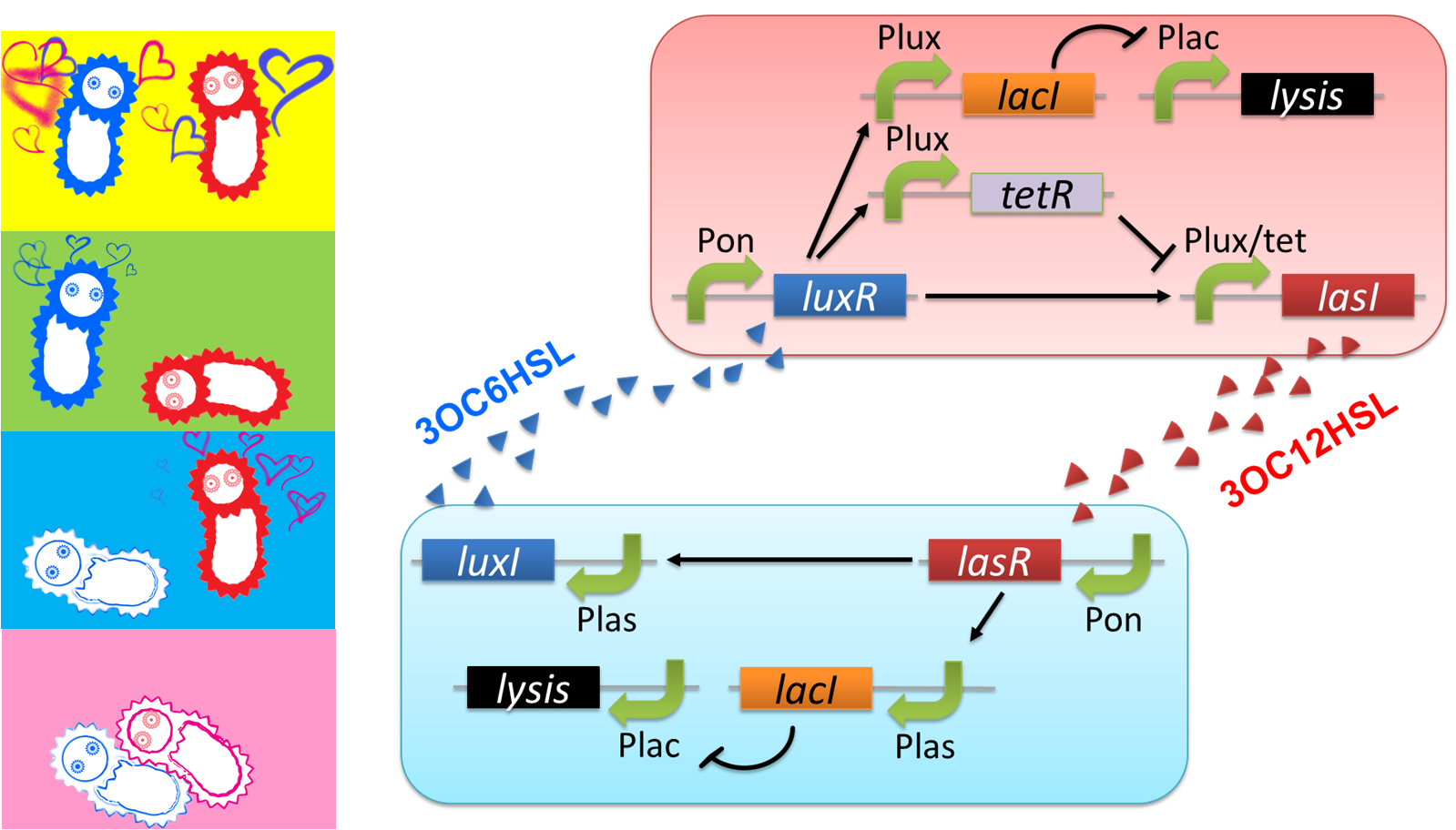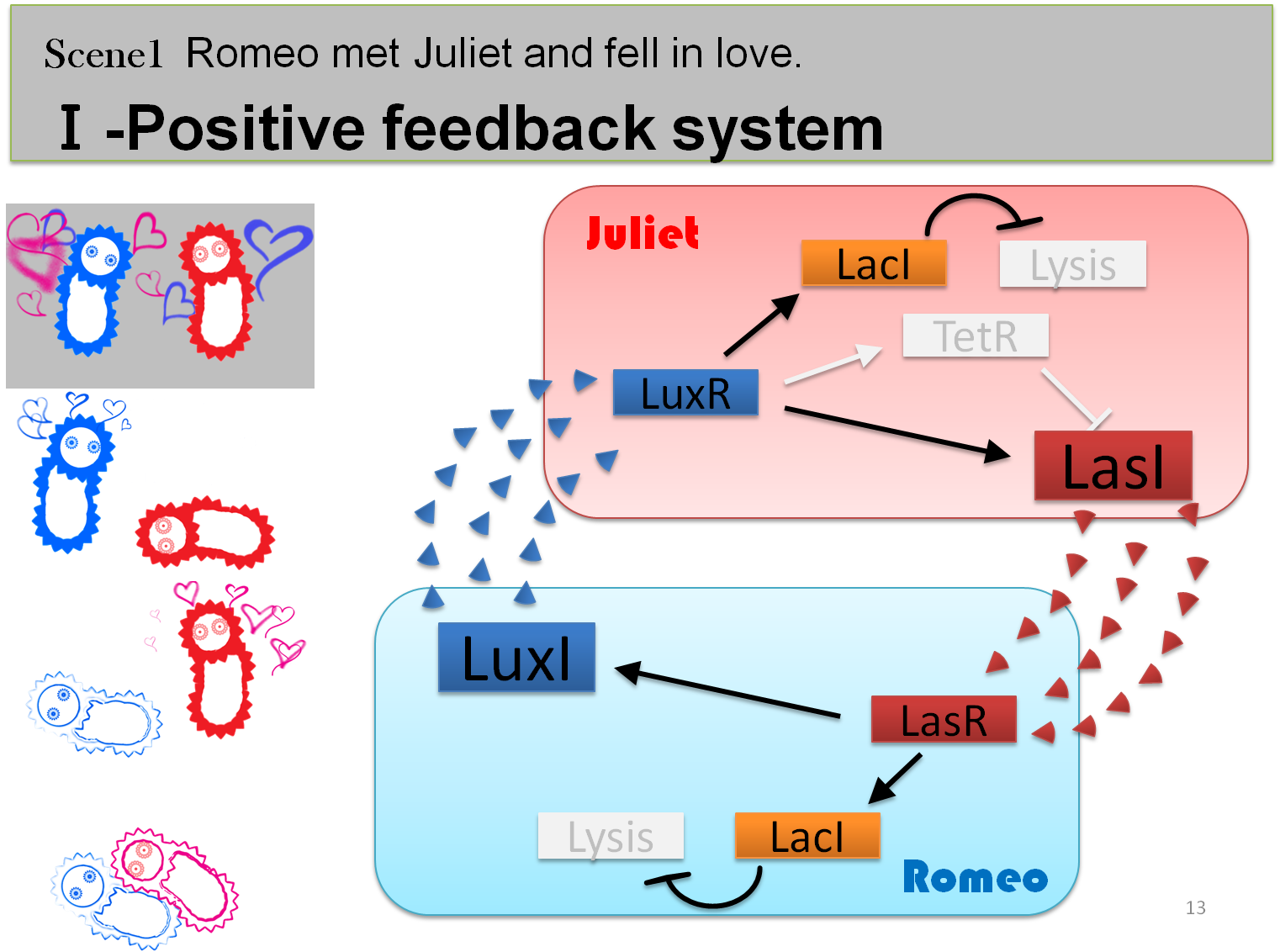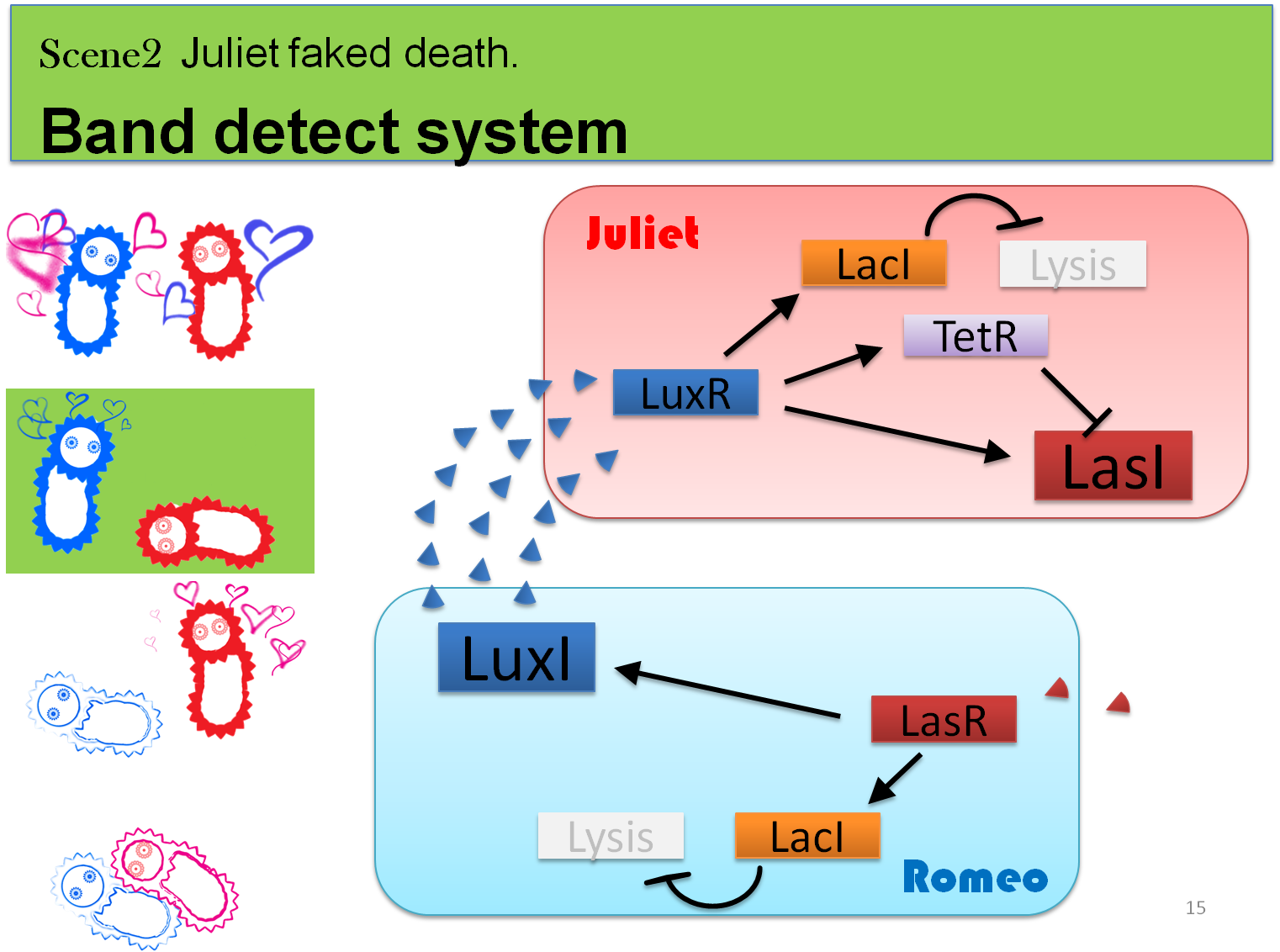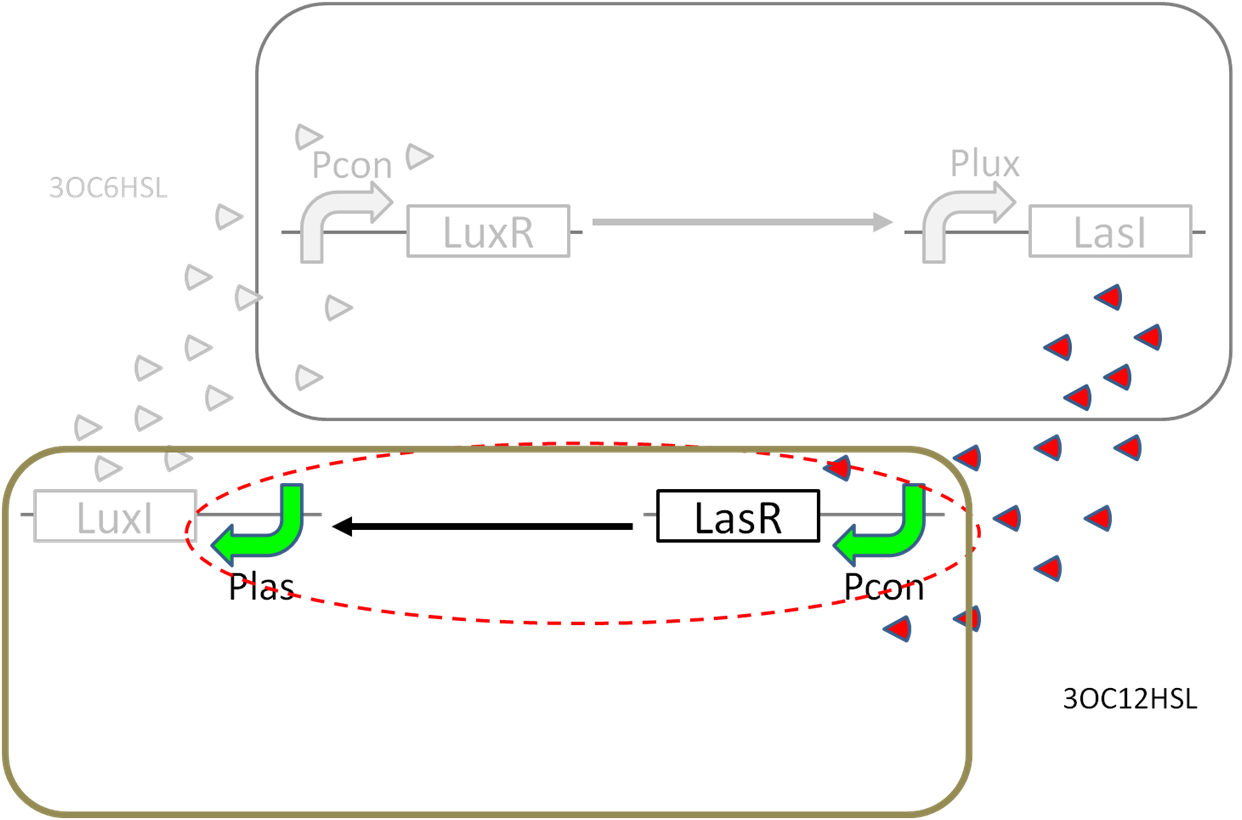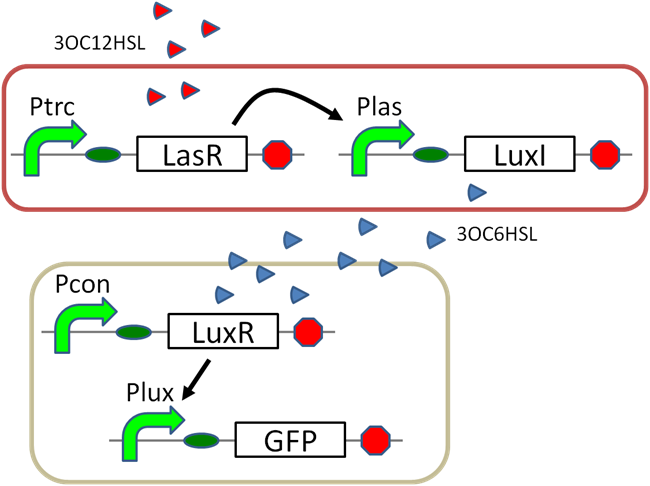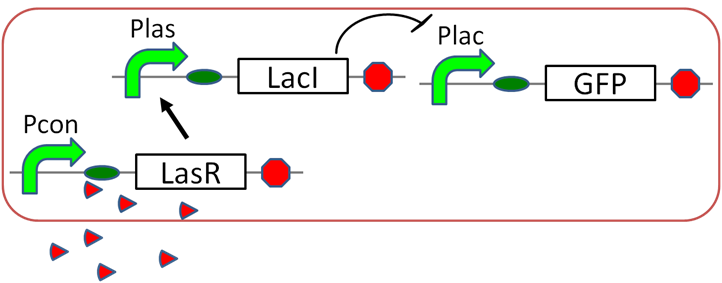Team:Tokyo Tech/Projects/rose pattern/index.htm
From 2012.igem.org
(→Achievement) |
|||
| Line 157: | Line 157: | ||
| TextB||TextB|- | | TextB||TextB|- | ||
|} | |} | ||
| + | |||
| + | |||
| + | |||
| + | |||
| + | |||
| + | |||
| + | |||
| + | |||
| + | |||
| + | |||
| + | |||
| + | |||
| + | {{tokyotechcss}} | ||
| + | {{tokyotechtop}} | ||
| + | {{tokyotechmenubar}} | ||
| + | <div class="whitebox"> | ||
| + | <div id="tokyotech" style=" font:bold ;left ; font-size: 50px; color: #1E90FF; padding: 10px;"> | ||
| + | cell-cell communication </div> | ||
| + | </div class="whitebox"> | ||
| + | <div class="whitebox"> | ||
| + | <div id="tokyotech" style=" font:Arial ;left ; font-size: 15px; color: #000000; padding: 30px;"> | ||
| + | __TOC__ | ||
| + | =Cell-Cell communication Project OVERVIEW= | ||
| + | ==Gene circuit== | ||
| + | In this project, we define the signal which E.coli gives out as the romantic feeling of Romeo and Juliet. | ||
| + | The story which we reproduce is divided into four scenes. | ||
| + | [[File:gene circuit tokyotech.png|500px|thumb|left|fig1,gene circuit over view]] | ||
| + | |||
| + | [[File:gene circuit positive feedback tokyotech.png|390px|thumb|right|fig2,positive feed back]] | ||
| + | [[File:gene circuit band detect system.png|390px|thumb|right|fig3,band detect system]] | ||
| + | [[File:gene circuit suicide tokyotech.png|390px|thumb|right|fig4,suicide machanism]] | ||
| + | [[File:gene circuit juliet suicide tokyotech.png|390px|thumb|right|fig4,suicide machanism]] | ||
| + | <br><br><br><br> | ||
| + | First, in positive feedback circuit, there are two types of E. coli, Cell R(Romeo) and Cell J(Juliet). In cell R (fig2), production of LasI is stimulated by LuxR/3OC6HSL complex and In cell J (fig2), production of LuxI is stimulated by LasR/3OC12HSL complex. This indicates that 3OC12HSL produced by cell R and 3OC6HSL produced by cell J indirectly stimulate each other’s production. We express the story of "Romeo met Juliet and fell in love instantly." by using "positive feedback circuit" as love which burns vigorously. | ||
| + | <br><br><br><br><br><br><br><br><br><br><br> | ||
| + | Second, "band detect system(fig3)" is a mechanism which controls production of a signal in Cell J body, when the amount of secretion of the signal by Cell R reaches more than fixed. We express the story of "The priest proposes she fake death and wake up 24 hours later.", using a "band detect system" as Juliette's suspended animation . | ||
| + | <br><br><br><br><br><br><br><br><br><br><br> | ||
| + | Third, LacI controls a suicide gene. If Cell R detects reduction of the signal from Cell J, suicide gene separate in Cell R body. | ||
| + | As a result, suicide gene is revealed and the number of individuals of Cell R becomes fewer. Reduction of individuals means reduction of the signal. We express the story of "Romeo took the poison." by using a suicide mechanism as suicide of Romeo. | ||
| + | <br><br><br><br><br><br><br><br><br><br><br> | ||
| + | Forth, by the same system as Cell R, suicide gene is revealed and the number of individuals of Cell R becomes fewer. Reduction of individuals means reduction of the signal. We express the story of "Juliet stabbed herself with the dirk." by using a suicide mechanism as suicide of Juliette. | ||
| + | |||
| + | Finaly, we argued about feasibility by performing a simulation using modeling about whether all the above stories are materialized. | ||
| + | |||
| + | ==Result== | ||
| + | |||
| + | In order to make the story of "Romeo and Juliet", we constructed and characterized several important parts and devices. First we characterized (Parts name), both of which are existing parts. Second, we designed and characterized a new (parts name). Third, we designed and characterized a NEW BioBrick device (Parts name),(explain). Forth, we confirmed that (mechanism). Finally, we simulated our project and confirmed the feasibility of our system. | ||
| + | <br><br><br> | ||
| + | |||
| + | =Scene1 Fall in love Positive feedback mechanism= | ||
| + | |||
| + | ==LasR generator== | ||
| + | [[File:gene circuit positive feedback tokyotech LasR assaydeta.png|450px|thumb|left|fig5,LasR generator]] | ||
| + | [[File:gene circuit positive feedback tokyotech LasR assay.png|300px|thumb|right|fig5,LasR generator]] | ||
| + | [[File:gene circuit positive feedback tokyotech LasR assayparts.png|350px|thumb|right|fig5,LasR generator deta]] | ||
| + | |||
| + | <br><br><br><br><br><br><br><br><br><br><br><br><br> | ||
| + | Text...[[ Team:Tokyo_Tech/Projects/LasR generator/index.htm | see more]] | ||
| + | |||
| + | <br><br><br><br><br><br><br><br><br><br><br><br><br> | ||
| + | |||
| + | ==3OC6HSL→pLuxLasI-PLas== | ||
| + | [[File:gene circuit positive feedback tokyotech 3OC6HSL→pLuxLasI-PLas assaydeta.png|450px|thumb|left|fig5,3OC6HSL→pLuxLasI-PLas]] | ||
| + | [[File:gene circuit positive feedback tokyotech 3OC6HSL→pLuxLasI-PLas assay.png|300px|thumb|right|fig5,3OC6HSL→pLuxLasI-PLas]] | ||
| + | [[File:gene circuit positive feedback tokyotech 3OC6HSL→pLuxLasI-PLas assayparts.png|330px|thumb|right|fig5,3OC6HSL→pLuxLasI-PLas deta]] | ||
| + | <br><br><br><br><br><br><br><br><br><br><br><br><br><br><br> | ||
| + | Text...[[ Team:Tokyo_Tech/Projects/3OC6HSL→pLuxLasI-PLas/index.htm | see more]] | ||
| + | <br><br><br><br><br><br><br> | ||
| + | |||
| + | ==3OC12HSL→pLasLuXI-PLux== | ||
| + | [[File:gene circuit positive feedback tokyotech 3OC12HSL→pLasLuXI-PLux assayparts.png|450px|thumb|left|fig5,3OC6HSL→pLuxLasI-PLas]] | ||
| + | [[File:gene circuit positive feedback tokyotech 3OC12HSL→pLasLuXI-PLux assay.png|300px|thumb|right|fig5,3OC6HSL→pLuxLasI-PLas]] | ||
| + | [[File:gene circuit positive feedback tokyotech 3OC12HSL→pLasLuXI-PLux assaydeta.png|320px|thumb|right|fig5,3OC6HSL→pLuxLasI-PLas deta]] | ||
| + | <br><br><br><br><br><br><br><br><br><br><br><br><br><br><br> | ||
| + | Text...[[ Team:Tokyo_Tech/Projects/3OC12HSL→pLasLuxI-PLux/index.htm | see more]] | ||
| + | <br><br><br><br><br><br> | ||
| + | |||
| + | ==positive feedback assay== | ||
| + | [[File:gene circuit positive feedback tokyotech positive feedback assayparts.png|450px|thumb|left|fig5,3OC6HSL→pLuxLasI-PLas]] | ||
| + | [[File:gene circuit positive feedback tokyotech positive feedback assay.png|300px|thumb|right|fig5,3OC6HSL→pLuxLasI-PLas]] | ||
| + | [[File:gene circuit positive feedback tokyotech positive feedback assaydeta.png|320px|thumb|right|fig5,3OC6HSL→pLuxLasI-PLas]] | ||
| + | <br><br><br><br><br><br><br><br><br><br><br><br> | ||
| + | <br><br><br><br><br><br><br><br><br><br><br><br><br> | ||
| + | |||
| + | =Band detect system= | ||
| + | |||
| + | ==Lux-Tet hybrid promoter assay== | ||
| + | [[File:gene circuit band detect system tokyotech Lux-Tet hybrid promoter assay parts.png|450px|thumb|left|fig5,Lux-Tet hybrid promoter assay]] | ||
| + | [[File:gene circuit band detect system tokyotech Lux-Tet hybrid promoter assay.png|300px|thumb|right|fig5,Lux-Tet hybrid promoter assay]] | ||
| + | [[File:gene circuit band detect system tokyotech Lux-Tet hybrid promoter assaydeta.png|320px|thumb|right|fig5,Lux-Tet hybrid promoter assay deta]] | ||
| + | <br><br><br><br><br><br><br><br><br><br><br><br> | ||
| + | Text...[[ Team:Tokyo_Tech/Projects/Lux-Tet hybrid promoter/index.htm | see more]] | ||
| + | <br><br><br><br><br><br><br><br><br> | ||
| + | |||
| + | =Scene3 Romeo Suicide = | ||
| + | |||
| + | ==Las→Lac assay== | ||
| + | [[File:gene circuit Suicide mechanism tokyotech Las→Lac assay, Lux→Lac assayparts.png|300px|thumb|left|fig5,3OC6HSL→pLuxLasI-PLas]] | ||
| + | [[File:gene circuit Suicide mechanism tokyotech Las→Lac assay, Lux→Lac assaydeta.png|250px|thumb|left|fig5,3OC6HSL→pLuxLasI-PLas]] | ||
| + | <br><br><br><br><br><br><br><br><br><br><br> | ||
| + | |||
| + | =Scene4 Juliet Suicide= | ||
| + | ==Lux→Lac assay== | ||
| + | [[File:gene circuit Suicide mechanism tokyotech Las→Lac assay, Lux→Lac assayparts2.png|300px|thumb|left|fig5,3OC6HSL→pLuxLasI-PLas]] | ||
| + | [[File:gene circuit Suicide mechanism tokyotech Las→Lac assay, Lux→Lac assaydeta2.png|250px|thumb|left|fig5,3OC6HSL→pLuxLasI-PLas]] | ||
| + | <br><br><br><br><br><br><br><br><br><br><br><br> | ||
| + | Text...[[ Team:Tokyo_Tech/Projects/Las→Lac assay, Lux→Lac assay/index.htm | see more]] | ||
| + | |||
| + | =modeling= | ||
| + | [[File:tokyotechromijurimodeling.png|350px|thumb|right|Romeo&Juliette signal change with times]] | ||
| + | |||
| + | Text | ||
| + | <br><br><br><br><br><br><br><br>><br><br> | ||
| + | [[File:tokyotechromijurimodeling formula.png|850px|thumb|center|Romeo&Juliette Formula]] | ||
| + | |||
| + | =Conclusion= | ||
| + | |||
| + | We succeeded in constructing (number) new BioBrick, (name). We characterized mechanism. From the experimental data and simulation result, we confirmed the feasibility of the project "Romeo and Juliette". | ||
Revision as of 17:48, 19 September 2012
Contents |
Abastract
In our project, we will reproduce the rose come out in the lines of the famous drama Romeo and Juliet by the synthesis of PHAs. PHAs can be detected by Nile-Red reagent by stained red, which looks exactly like rose. the area of PHAs stained red by Nile-Red reagent may even looks like a rose parterre. As E.coli is an unexpensive and easily available bacterium, it's commonly considered to be the ideal PHA producer. First of all, we must cut and paste the right gene sequences of PHA synthesis into E.coli .We take the gene phaC1-A-B from R.eutropha and paste it into the vector of IGEM format and then put this special plasmid into E.coli. Then we culture these E.coli on our LB medium with Nile Red. After that ,we will culture the colonies overnight to make sure that PHA can accumulate without disturbance.If things go well the Nile-Red reagent in the colony will turn red after detecting the existence of PHA. 9/4
Achievement
TEXT
Introduction
What's PHA
PHAs are the abbreviation of Polyhydroixyalkanoates, which are linear polyesters produced in nature by bacterial fermentation of sugar and lipids. They are produced by the bacteria to store carbon and energy. PHAs are also a kind of bio-plastics, which are more sustainable because they can be biodegraded in the environment a lot more faster than fossil-fuel plastics. PHBs are the abbreviation of polyhydrobutyrates ,which are a kind of polyhydroalkanoates. In our project we used the poly-3-hydroxybutyrate(P3HB)form of PHBs, which is the most common type of polyhydroxyalkanoate synthesized by the gene phaC1-A-B from Ralstonia eutropha H16.
As long as we know ,there was no team succeeded in synthesizing PHAs in iGEM format before. But this year we are very excited to tell you that we made it and we are going to show it to all of you. 9/4
Project Overview
Pre-experiment
Before the igem format vector coming,we actually synthesized PHA by using the vector PSB1C3 on E.coli JM109.We synthesized PHA by following steps. 1.Take the right gene phaC1-A-B from R.eutropha, and increase it by PCR 2.Insert the gene into the PSB1C3 vector by using a series of genetic operation including ligation and ethanol precipitation 3. Put the plasmid into E.coli JM109 by using the technique of transformation and plant it on LBmedium with Cm and Nile-Red then culture it overnight. 4. Check whether colonies are stained orange under UV 5. Produce PHAs by quantity by main culture the E.coli 6. Collect the strains and freeze dry it. 7. Stain the product and Measure the weight
Assay In order to check whether the product is PHA or not ,we used several ways of assay. 1. Read the gene sequence of the gene 2. See whether the product can be stained by Nile-Red or Nile-Blue 3. Make sure the product under microscope 9/4
Production of PHB main culture
Protocol
1 Wash Erlenmeyer flasks with mild detergent then rinse with distilled water.
2 Measure 4% LB medium and add it to each Erlenmeyer flask inside clean bench.
3 Add 96% distilled water to each Erlenmeyer flask and cover the flasks with four-folded aluminum foil.
4 Set all flasks into autoclave
5 Clear the clean bench
6 Add 1/1000 Chloramphenicol and 4% Glucose solution (50%) after the medium is completely cooled.
7 Add 2% preculture solution into each flasks and shaking culture at 37 ° C for 72 hours.
Collection of PHBs in JM109
1 Weigh empty 50ml falcon tube without lid and make a record.
2 Add some culture solution into each tube.
3 Set the tubes into centrifuge and make sure that the label faces outside.
4 4 ° C ,5000G ,10min in centrifuge.
5 Remove the supernatant with electric pipettor then add culture solution and set in centrifuge again.
6 After adding all the culture solution and setting in centrifuge, remove the supernatant and add water, set in centrifuge again.
7 Remove the supernatant and add a little amount of water.
8 Cover the tubes with double layers of parafilms and fully freeze them.
Freeze drying
1 Poke several holes on the tubes’ parafilm with toothpick.
2 Set the tubes on the freeze drying machine.
3 Freeze dry for 3 days.
date9/4
| Text | Text | Text | Text | Text | Text | Text |
| Colorblindness | content | content | korekaigyou | kaigyou kore | content.####### | content.####### |
| Familial Hypercholesterolemia | content | content | content | content | content.####### | content.####### |
| Myc-gene Cancer | Text | Text | Text | Text | Text | Text.####### |
| Text | Text | Text | Text | Text | Text | Text.####### |
| Text | Text | Text | Text | Text | Text | Text |
| Colorblindness | content | content | korekaigyou | kaigyou kore | content.####### | content.####### |
| Familial Hypercholesterolemia | content | content | content | content | content.####### | content.####### |
| Myc-gene Cancer | Text | Text | Text | Text | Text | Text.####### |
| Gene Circuit |
| TextA | TextA |
| TextB | TextB |
| TextB | TextB |
| TextB | TextB |
| TextB | TextB |
| TextB | TextB |
| TextB | TextBv |
| TextB | - |
Cell-Cell communication Project OVERVIEW
Gene circuit
In this project, we define the signal which E.coli gives out as the romantic feeling of Romeo and Juliet. The story which we reproduce is divided into four scenes.
First, in positive feedback circuit, there are two types of E. coli, Cell R(Romeo) and Cell J(Juliet). In cell R (fig2), production of LasI is stimulated by LuxR/3OC6HSL complex and In cell J (fig2), production of LuxI is stimulated by LasR/3OC12HSL complex. This indicates that 3OC12HSL produced by cell R and 3OC6HSL produced by cell J indirectly stimulate each other’s production. We express the story of "Romeo met Juliet and fell in love instantly." by using "positive feedback circuit" as love which burns vigorously.
Second, "band detect system(fig3)" is a mechanism which controls production of a signal in Cell J body, when the amount of secretion of the signal by Cell R reaches more than fixed. We express the story of "The priest proposes she fake death and wake up 24 hours later.", using a "band detect system" as Juliette's suspended animation .
Third, LacI controls a suicide gene. If Cell R detects reduction of the signal from Cell J, suicide gene separate in Cell R body.
As a result, suicide gene is revealed and the number of individuals of Cell R becomes fewer. Reduction of individuals means reduction of the signal. We express the story of "Romeo took the poison." by using a suicide mechanism as suicide of Romeo.
Forth, by the same system as Cell R, suicide gene is revealed and the number of individuals of Cell R becomes fewer. Reduction of individuals means reduction of the signal. We express the story of "Juliet stabbed herself with the dirk." by using a suicide mechanism as suicide of Juliette.
Finaly, we argued about feasibility by performing a simulation using modeling about whether all the above stories are materialized.
Result
In order to make the story of "Romeo and Juliet", we constructed and characterized several important parts and devices. First we characterized (Parts name), both of which are existing parts. Second, we designed and characterized a new (parts name). Third, we designed and characterized a NEW BioBrick device (Parts name),(explain). Forth, we confirmed that (mechanism). Finally, we simulated our project and confirmed the feasibility of our system.
Scene1 Fall in love Positive feedback mechanism
LasR generator
Text... see more
3OC6HSL→pLuxLasI-PLas
Text... see more
3OC12HSL→pLasLuXI-PLux
Text... see more
positive feedback assay
Band detect system
Lux-Tet hybrid promoter assay
Text... see more
Scene3 Romeo Suicide
Las→Lac assay
Scene4 Juliet Suicide
Lux→Lac assay
Text... see more
modeling
Text
>
 "
"



